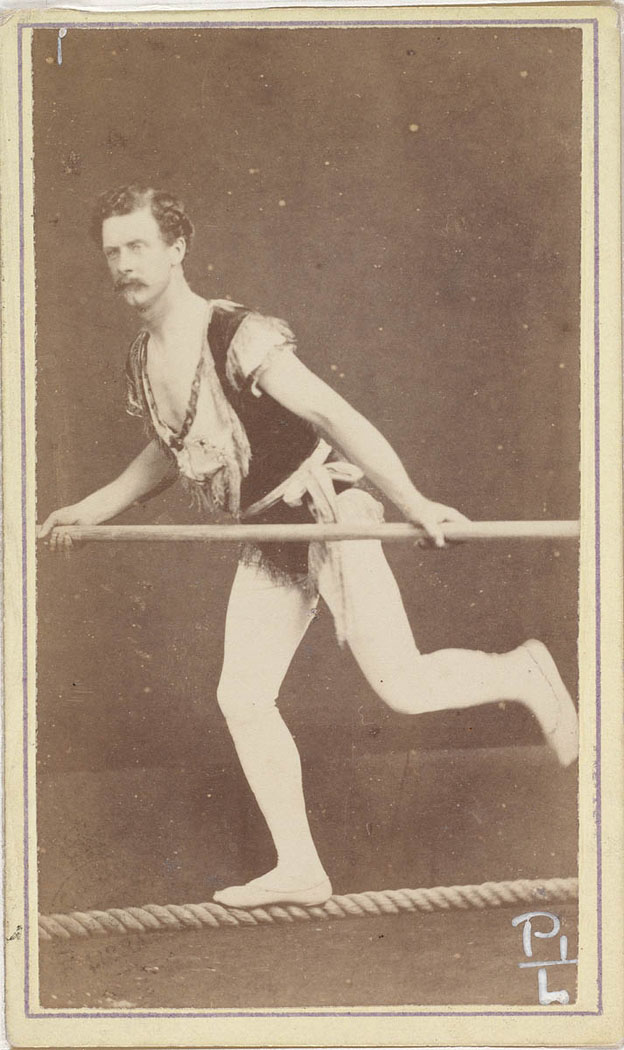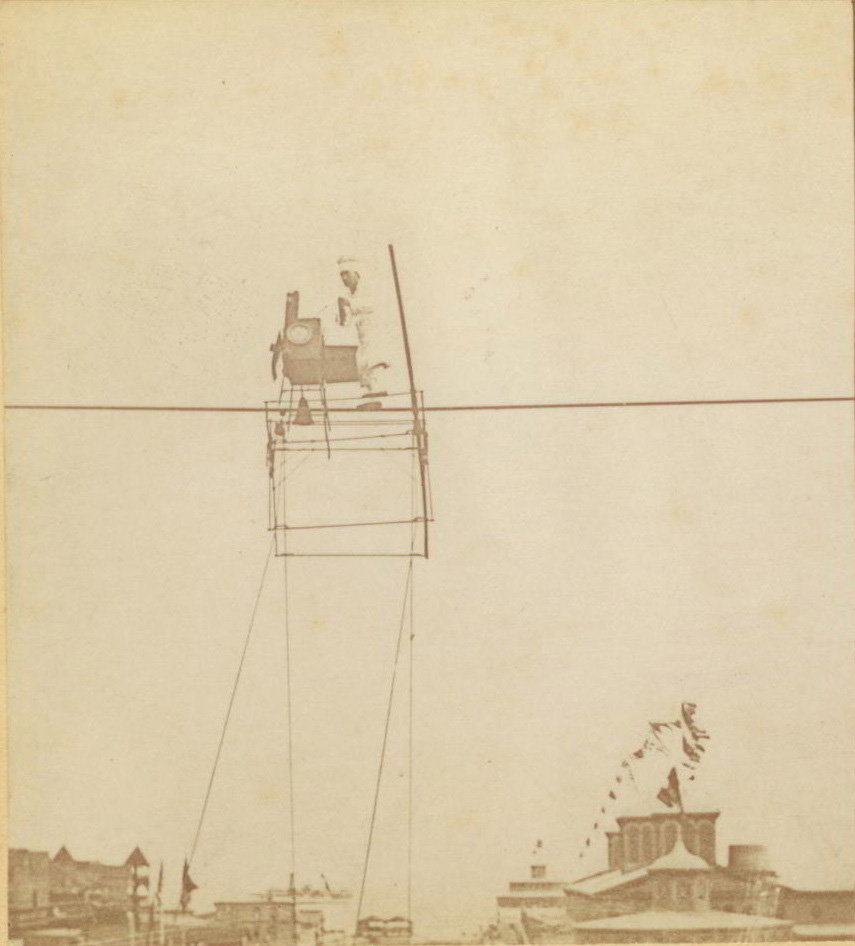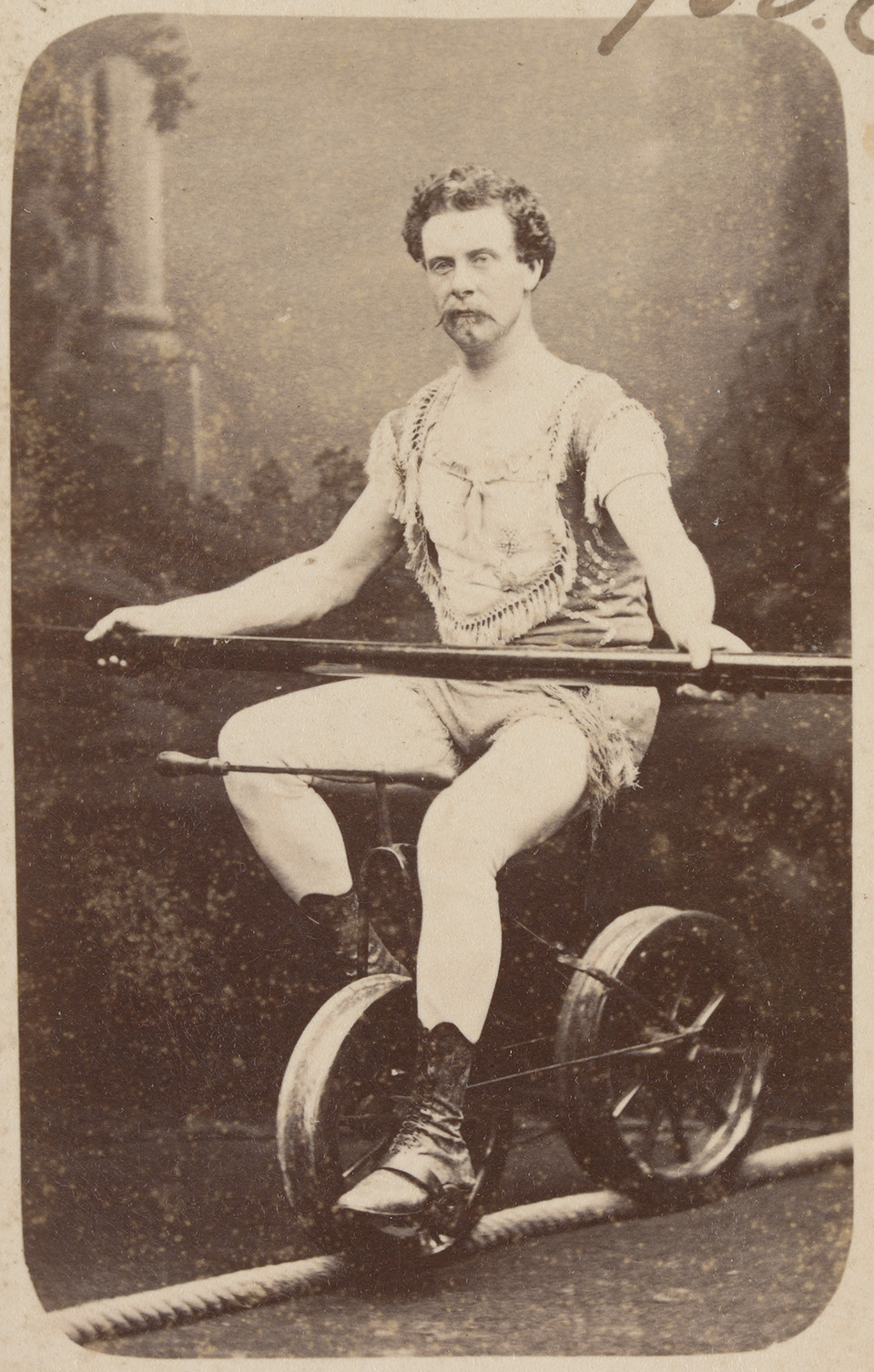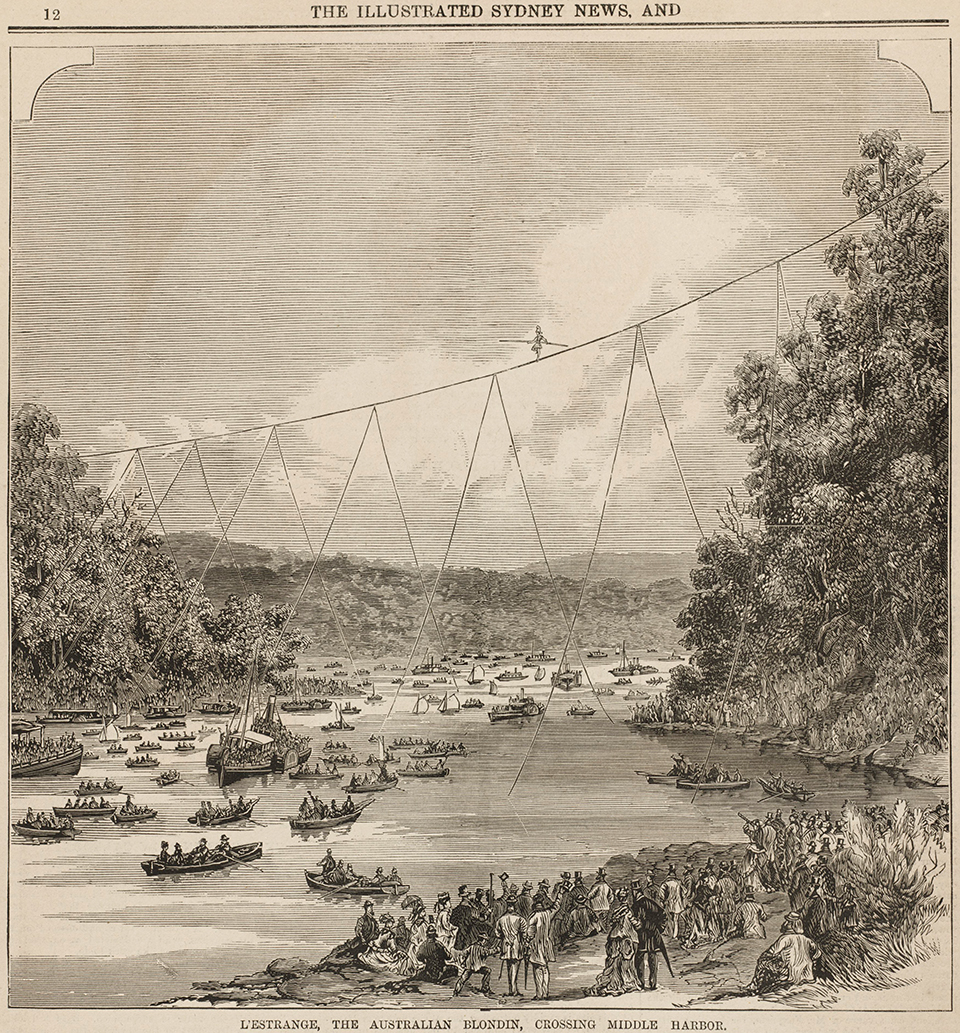The Dictionary of Sydney was archived in 2021.
L'Estrange, Henri
Citation
Persistent URL for this entry
To cite this entry in text
To cite this entry in a Wikipedia footnote citation
To cite this entry as a Wikipedia External link
L'Estrange, Henri
[media]During the 1870s and 1880s, public entertainment in Sydney was often a spectacle, the more dangerous the better. One such entertainer was Henri L'Estrange, tightrope walker and aeronautical balloonist. Modelling himself on the famous French wire-walker Blondin, L'Estrange performed a number of wire walks in the 1870s, culminating in three walks across Sydney Harbour at Middle Harbour in 1877. As well as his wire acts, L'Estrange was an early balloonist, and made a series of flights over Sydney in the early 1880s, not all of which ended well.
Early years
Henri L'Estrange was a Melbournian, born about 1842 in Fitzroy. Although the story of his early years is unclear, he first came to public attention in 1873 as a member of a Melbourne performance group, the Royal Comet Variety Troupe, a gymnastic, dancing and comedic vocal combination with Miss Lulu L'Estrange and Monsieur Julian. As part of this troupe, L'Estrange performed in Melbourne and Tasmania throughout 1873 and 1874, with Henri and Lulu performing together on the tightrope. [1] In 1876, L'Estrange performed solo for the first time in Melbourne, and quickly gained a reputation as a fearless performer.
Tightrope [media]walking had grown in popularity in Australia through the 1860s, following reports reaching the colonies of the exploits of the great French walker, Chevalier Blondin, who crossed Niagara Falls in 1859. By the mid-1860s, Australian wire walkers or funambulists (one who performs on a tightrope or a slack rope) were modelling themselves on Blondin, copying his techniques, with several even calling themselves 'the Australian Blondin'. The popularity of the name surged after the original Blondin visited Australia in 1874, performing his highwire act in Brisbane, Sydney and Melbourne. By the mid-1880s, there were at least five 'Blondins' performing regularly in Sydney and elsewhere.
L'Estrange [media]began using the moniker 'the Australian Blondin' from early 1876. Arriving in Sydney from Melbourne, L'Estrange erected a large canvas enclosure in the Domain and began a regular series of performances on the tightrope. His opening night on 26 January 1877 attracted a reported crowd of between two and three thousand people. Newspaper reports commented that his performance was so like that of the original Blondin that people could be forgiven for thinking they had seen the world-renowned rope-walker. With his rope suspended 40 feet (12 metres) above the ground, L'Estrange walked backwards and forwards, walked in armour, walked covered in a sack, used and sat on a chair, cooked and rode a bicycle, all on the rope. His show also included a fireworks display for the public's entertainment. [2]
L'Estrange performed in the Domain from January through to April 1877, but not without incident. On 7 February 1877, as L'Estrange neared the end of his wire act, sparks from the fireworks going off around him fell into the nearby store of gunpowder and fireworks, igniting them. The store's shed was demolished, a surrounding fence knocked down, part of L'Estrange's performance tent caught fire, and two young boys were injured.
The harbour crossing
L'Estrange's Domain show was in preparation for his main Sydney performance: crossing Sydney Harbour.
In late March 1877, advertisements began to appear in the Sydney newspapers for L'Estrange's proposed harbour crossing. The first public performance was set for Saturday 31 March, with L'Estrange having organised 21 steamers to convey spectators from Circular Quay to a special landing stage close to his performance area. L'Estrange advised those wishing to see his performance to travel on his steamers as they were the only ones with permission to land passengers. Of course this did not stop other entrepreneurs and captains from carrying spectators to and fro.
Prior to the public performance, L'Estrange undertook the crossing for a select audience of 'gentlemen' and members of the press. That crossing was a success, and was well reviewed in the papers, no doubt adding to the crowd's anticipation for the Saturday show. [3] Sadly, bad weather postponed the performance, which did not go ahead until 14 April. [4]
At 1 o'clock on Saturday April 14, the steamers began leaving Circular Quay, conveying 8,000 of an estimated 10,000-strong crowd to Middle Harbour. The remainder were reported to be walking from St Leonards, with a toll being collected by collectors along the way. Spectators clambered up the sides of the bay for vantage points, while hundreds more stayed on board steamers, yachts and in row boats below. The rope was strung across the entrance to Willoughby Bay, from Folly Point to the head of the bay, a reported length of 1420 feet or 433 metres, 340 feet (104 metres) above the waters below. [5] The distance meant that two ropes were required, spliced together in the centre, to reach the other side, with 16 stays fixed to the shore and into the harbour to steady the structure.
At [media]precisely 4 pm L'Estrange appeared from his tent on the eastern shore. Dressed in a dark tunic, red cape and turban, he stepped onto the rope and began his walk. Amid the cheers of the onlookers, L'Estrange walked confidently to the centre where the rope was joined, slowed and moved past the spliced portion. Beyond the halfway mark, L'Estrange stopped, stood on his right foot then lowered himself to his knee, before sitting and waving a handkerchief to the crowd. He next lay down on his back, before returning to sitting and examining the crowd below through a small telescope he produced from his pocket. Satisfied with the view, the numbers, and probably the takings, L'Estrange returned to his feet and walked the remainder of the rope to terra firma.
The successful crossing was greeted with enthusiastic cheers, the tunes of the Young Australian Band, the Albion Brass Band and Cooper and Bailey's International Show Band, who had all come to entertain the crowds, and the shrilling of the steamers' whistles. The Young Australian Band played 'The Blondin March', a piece composed specially by Mr J Devlin. L'Estrange soon reappeared in a small row boat to greet the crowds, although many had already rushed the steamers to leave, resulting in a few being jostled into the harbour. [6]
While the Illustrated Sydney News proclaimed it a truly wonderful feat, performed with the greatest coolness and consummate ability, not all of Sydney's press were so enthusiastic. The Sydney Mail questioned the worth of such a performance beyond the profits made, commenting that it was
a mystery to many minds why such large concourses of people should gather together to witness a spectacle which has so little intrinsic merit. There is nothing about it to charm the taste or delight the fancy. [7]
Despite the criticism, L'Estrange performed at least once more at Middle Harbour, although crowds were down to a few hundred, requiring only four steamers to transport them. The same night he was guest of honour at a testimonial dinner held at the Victoria Theatre, where he was presented with a large gold star, inscribed with scenes of his latest triumph and the date of his public performance. Measuring three inches (7.6 centimetres) across, it was centred with a 1½ carat diamond. An illuminated address and a bag of sovereigns, collected from his admirers, were also handed over. [8] L'Estrange thereafter took his show on the road, going first to Brisbane in May 1877, and afterwards (reportedly) to Singapore, England and America. [9]
Ballooning adventures
In April 1878, L'Estrange reappeared on the Australian scene with a new performance – ballooning. The first balloon ascent in Australia had been made in Melbourne in 1853, with Sydney following five years later in December 1858. The idea that people could be lifted from the ground to fly and return safely fired the imagination of the public, and the novelty of balloon ascents continued to draw large crowds through the 1860s and 1870s. No doubt the very real chance of disaster and injury added to the crowd's keen interest, as mishaps were not uncommon.
L'Estrange came to Sydney with his balloon in November 1878, accompanied by reports of successful flights already made in India. [10] In a confident appraisal of L'Estrange's new venture, the Sydney Morning Herald wrote:
[L'Estrange's] balloon has been fitted with the newest applications, amongst others a parachute, which in the event of anything going wrong, would prevent the too rapid descent of the aerial voyager. Another novelty is the fixing of bags of sand round the mesh which covers the balloon, the principle of which is that by emptying these, and so lessening the weight, the balloon will ascend. The process is chiefly intended to be an easy method of avoiding buildings…He is perfectly confident that he will prove successful in travelling amongst the regions of the clouds, and, if so it will prove an agreeable variety after the many failures we have had. [11]
In a letter to the City Council, L'Estrange sought permission for the use of the Exhibition grounds in Prince Alfred Park for his first attempt. [12] L'Estrange struggled to fill the balloon through the afternoon of 17 November 1878, with gas supplied by the Australian Gas Light company. By 5 pm, the crowd was getting restless and L'Estrange decided to attempt the lift, despite the balloon not being fully inflated. To lighten the load he removed the car in which he was to sit and instead sat in a loop of rope. The balloon managed only to drag him across the park before clearing the fenceline and landing on a railway truck in the yards of the Sydney railway station next to the park. [13]
L'Estrange wrote to the Council again, this time asking for permission to use Belmore Park for a second attempt. [14] Much like his first attempt, the second ended in failure. Once again the balloon took much of the day to fill, with the lift going ahead at 5 pm on the afternoon of 7 December 1878. The first attempt dragged him approximately 100 yards (91 metres) through the crowd. Returning to the start point, L'Estrange tried again, shooting up into the air approximately 45 metres and sailing away towards the south, before descending again and being dragged across the park. The crowd feared the balloon would crash but once more it lifted, up and over the roof of Carters' Barracks. L'Estrange, realising that the balloon was not going to lift higher, threw out the anchor, which caught in the spouting of a building and threw the balloon into the drying yard of the Benevolent Asylum, where it caught in the washing lines and wires and was practically destroyed. [15] Still, L'Estrange's place in Sydney hearts had been established and a well-attended benefit was held at the Theatre Royal on 19 December 1878.
Despite these setbacks, L'Estrange persisted, returning to Sydney in August 1880 (after a spectacular failure in Melbourne) to prepare for another attempt. At last success came, with a flight from Cook Park over the harbour to Manly on 25 September 1880, and a second successful flight the following day in Manly. Buoyed by his achievement, L'Estrange set himself a second flight day in March 1881. With his reputation already well known in Sydney, and a successful flight on record, a crowd of over 10,000 turned up in the Outer Domain to see the show.
Again the balloon took longer to inflate than anticipated, and the crowd grew restless, including a group of larrikins who had scaled the fence. L'Estrange was presented with the choice of abandoning the attempt and risking 'maltreatment from the crowd' or proceeding – a 'Hobson's Choice' as the Herald described it. He chose the latter and the lift commenced at 9.30 pm. As with his first failed attempt, the car was deemed too heavy, and he disconnected it from the balloon, and sat below in a loop of rope. At first all seemed well, as the balloon lifted above the heads of the crowd, hovering for a moment before first heading over Hyde Park then going north over the harbour and Rushcutters Bay. L'Estrange attempted to seal the valve to prevent more gas escaping, but in doing so unseated himself and was soon dangling under the balloon high above the ground. Managing to right himself, he became woozy from the escaping gas and lashed himself to the ropes to prevent a fall. Realising the attempt was now a danger to himself and the balloon, L'Estrange set out the grappling hooks to catch onto something and bring the balloon down. However the ropes had become tangled and the hooks were too short.
L'Estrange's balloon [media]descended rapidly over the rooftops of Woolloomooloo, slamming into a house near the corner of Palmer Street and Robinson Lane. L'Estrange managed to disentangle himself and scrambled down from the rooftops to a waiting crowd, who whisked him away to Robinson's hotel on the William Street corner. At the crash site, during an attempt to free the balloon, the escaping gas was ignited when the resident of the house opened a window to see what the commotion was and the gas came into contact with the open flame of the room lighting. The resulting explosion destroyed the balloon, burnt a number of bystanders and caused a panicked crush as people tried to flee the scene. [16]
Although a Masonic benefit was held in his honour to try to recoup some of his losses, the fiasco spelt the end of L'Estrange's aeronautical career.
A return to the wire
Curiously, in a change of direction in March 1882, L'Estrange applied to the Sydney City Council to establish a juvenile pleasure gardens at the Paddington Reservoir. The fun park was to have a variety of rides, a maze, merry-go-rounds and a donkey racecourse. L'Estrange proposed the park to be free entry with all monies being made via the sale of refreshments on site. While he was given permission, the park does not appear ever to have opened. [17]
Following the disastrous balloon attempt and the failed pleasure grounds, L'Estrange decided to return to what he knew best, tightrope walking. In April 1881 L'Estrange, 'the hero of Middle Harbour', had performed at the Garden Palace on the high-rope as part of the Juvenile Fete, with other acrobats, contortionists and actors. [18] With proof of the continuing popularity of the rope act, he decided to return to his greatest triumph; the spectacular crossing of the harbour in 1877 which had still not been repeated. In late 1882, L'Estrange advised the public that he would cross the harbour once more, this time riding a bicycle across Banbury Bay, close to the site of his original success.
As with his previous crossings, steamers took the crowds from Circular Quay, although this time only four were needed, while another 600–700 people made their own way to the site. The ride was scheduled for 3 pm on 23 December, but delays meant L'Estrange did not appear until 6 pm. Although the length of rope was over 182 metres, it was only just over nine metres above the water. The stay wires were held in boats on either side, with the crews rowing against each other to keep it steady. L'Estrange rode his bicycle towards the centre, where, with the rope swinging to and fro, he stopped briefly to steady himself but instead, realising he was losing his balance, he was forced to leap from the rope and fell into the water below. Although he was unhurt, it was another knock to his reputation. A repeat attempt was announced for the following weekend. Again steamers took a dwindling crowd to Banbury Bay where they found L'Estrange's rope had been mysteriously cut, and he cancelled the performance. The Daily Telegraph reported that many in the crowd, who had paid for tickets on the steamers, felt they had been scammed.
L'Estrange fades away
With his reputation in tatters after the balloon crash and the attempted second harbour crossing, L'Estrange slowly slipped out of the public eye. In December 1883 he was reported as performing again on the highwire at the Parramatta Industrial Juvenile exhibition. While his act attracted favourable publicity, 'his efforts were not received with the amount of enthusiasm they certainly deserved'. [19]
In April 1885 a benefit was held for L'Estrange, again at the Masonic Lodge, like the one held after his balloon misadventure. It was advertised that the benefit, under the patronage of the Mayor and Aldermen of Sydney, and with Bill Beach, world champion sculler in attendance, was prompted because L'Estrange had 'lately met with a severe accident'. [20] The nature of the accident is unknown, but it may have been a fall from his wire, and would help explain the end of this part of his performances.
His apparent decline in popularity may have been as much a reflection of the public's changing taste for entertainment as it was a comment on his act. By the time L'Estrange returned to Sydney to attempt his second harbour crossing in 1882, the city was awash with Blondin imitators. At least five were performing in Sydney from 1880 under variations of the title from the Young Blondin (Alfred Row) to the Blondin Brothers (Alexander and Collins), the great Australian Blondin (James Alexander), the original Australian Blondin (Collins), the Great Australian Blondin (Signor Vertelli), the Female Australian Blondin (Azella) and another Australian Blondin (Charles Jackson). So many Blondins prompted one Sydney resident to write to the Herald and complain of the Blondin business that saw people walking on high wires wherever the opportunity arose. He noted that he had seen one walking on a wire in Liverpool Street in the city with a child strapped to his back. The practice which had become so popular was both dangerous and, the correspondent thought, likely to be unlawful, particularly in the risk of harming others. [21]
In 1886 L'Estrange again applied to the Sydney City Council for permission to establish a carnival act called The Rocker in Belmore Park. The Rocker consisted of a boat which, propelled by horsepower, gave the impression of being at sea. Permission was granted but like his juvenile pleasure grounds, there is no evidence that it was ever erected. [22]
After this, L'Estrange slips from view in Sydney. It is possible he returned to Melbourne or took his act back overseas. While his later years in Sydney were more often beset by failure and fiasco, he remains the only tightrope performer ever to have walked across the waters of Sydney Harbour.
Notes
[1] Mercury (Hobart), 28 February 1873, p 2
[2] Sydney Morning Herald, 27 January 1877, p 3
[3] Town and Country Journal, 7 April 1877, p 540
[4] Sydney Morning Herald, 4 May 1877, p 7
[5] Town and Country Journal, 7 April 1877, p 540
[6] Sydney Morning Herald, 16 April 1877 p 5
[7] Sydney Mail, 21 April 1877, p 496
[8] Sydney Morning Herald, 24 April, 1877, p 4
[9] Queenslander, 28 April 1877, p 27
[10] Sydney Morning Herald, 1 November 1878, p 5
[11] Sydney Morning Herald, 1 November 1878, p 5
[12] City of Sydney Archives, 2 November, 1878, Letters Received 26/154/0981
[13] Sydney Morning Herald, 18 November 1878, p 5
[14] City of Sydney Archives, 21 November, 1878, Letters Received 26/154/1044
[15] Sydney Morning Herald, 9 December 1878, p 5
[16] Sydney Morning Herald, 16 March 1881, p 6
[17] City of Sydney Archives, 22 March 1882, Letters Received 26/183/475
[18] Sydney Morning Herald, 16 April 1881, p 2
[19] Sydney Morning Herald, 31 December 1883, p 4
[20] Sydney Morning Herald, 14 April 1885, p 2
[21] Sydney Morning Herald, 19 February 1880, p 1
[22] City of Sydney Archives, 12 January 1886, Letters Received 26/209/0105







